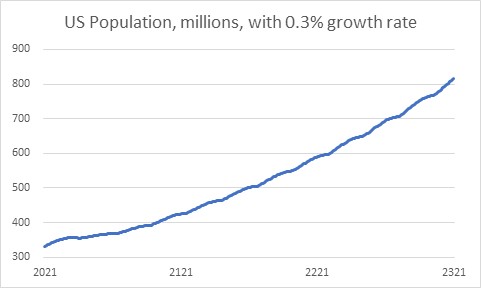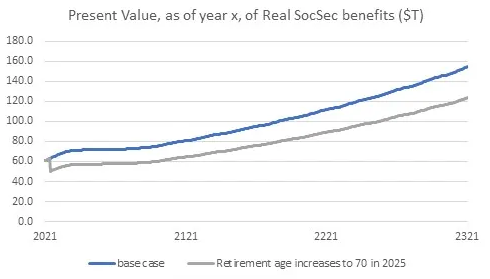I’m going to depart temporarily from my usual inflation-focused column to write about something that affects all Americans, and propose a simple solution to a bedeviling problem – a solution that is guaranteed to work.
The issue is Social Security. According to the US debt clock, which keeps track of this sort of thing, the present value of the (off balance sheet) Social Security obligation is $22.8trillion. What has happened is that over the years since the Social Security program was created, people are living longer and benefits have increased; a secondary problem that will someday solve itself is that the population pyramid in the US is almost inverted as the baby boom generation ages. Consequently, current workers have to contribute quite a bit to support retired workers, and this will get worse in the near future (since Social Security is not a savings program but a transfer program, the current workers plus taxpayers pay for retirees).
The full retirement age has been raised occasionally in the past, each time to ‘fix’ the system, and each time under a firestorm of controversy. Raising the retirement age temporarily improves the fiscal position of the program, but ultimately fails because people are living longer. That’s a good thing, but it’s really bad as the ‘retired’ population gets bigger and bigger and the US population growth rate grows more and more slowly.
To demonstrate the problem and my solution, I ran some relatively simple simulations. I started with the current US population distribution by age.[1] For each subsequent year, I applied the 2020 period life table for the Social Security area population, as used in the 2023 Trustees Report.[2] For simplicity I used the females table. For new births, I took the prior year’s 25-year-old cohort and multiplied by 1.1, which resulted in an average population growth rate of 0.3% per year (which was roughly the low set in the pandemic, so very conservative). This takes the population of the US from 332mm in 2021 to 815mm, three centuries from now. (Bear with me; I know it’s ridiculous to project anything 300 years from now but this is for demonstration purposes).

I am also assuming that the current average benefit of $20,326.56 stays constant in real terms, and discount all future benefits using a 2% real interest rate. It’s important to realize that in what follows, I am showing 2021 dollars. Nominal dollars would be a lot higher. Another caveat is that I am implicitly assuming that people who are 1 year old, who have accrued zero Social Security benefits, can still be expected to cost the system in an economic sense even though in an accounting sense the government does not yet have a liability to those future-workers. I am also assuming that the entire population eventually works and earns a Social Security benefit. As a consequence of these last two assumptions, my number for “Present Value of Real Social Security Benefits” is about 2.65x higher than the official number.
However, it’s not important to get the accounting exactly right as long as we have the dynamics approximately right. If it makes you feel better, divide all of the numbers in the following charts by 2.65. It won’t change their shape.
I am also not assuming any increase in longevity over time, which is unrealistic but I think is what the SSA also assumes. My solution is still absolute, as long as longevity doesn’t advance very rapidly, forever.
So, under those assumptions and a fixed retirement age of 67, here’s what the PV in 2021 dollars looks like over the next 300 years.

It’s really not as bad as all that – in terms of dollars/population, it’s pretty stable. But this assumes no increase in longevity or benefits, which has historically been a bad assumption. This is probably not sustainable. So let’s change the retirement age. In 2025, we increase the retirement age to 70, ignoring for now the utter predictability of the firestorm that would erupt, and fairly so, if we did this.

That doesn’t really change the picture much. It lowers the overall number but the number still grows. And it would be really difficult to get even this change. Anyone remotely close to retirement age would be furious at having that brass ring snatched from them. And this small effect is from only a three year increase in the retirement age! It’s no wonder that everyone talks about Social Security’s solvency, but no one does anything about it. Nothing that you could actually accomplish, seems to have a big enough effect to be worth doing.
Here is my proposal. Starting in 10 years, raise the full retirement age by just 1 month. But do it every year after that. And, here’s the key word: forever.
Someone who is 57 today would still retire at the age of 67, so it doesn’t really affect them. Someone who is 45 today would retire at 68. They’re not really happy about the extra year, but that’s better than the prior example which was 3 years. Someone who is 33 today would retire at 69. That’s still better than the prior proposal, for them. Someone who is 21 today would retire at 70. They’re no worse off, and arguably lots better off because the 20-somethings all assume there won’t be a Social Security when they are old enough to claim it. With this proposal, there would be. And unlike the current spastic attempts to repair the system, this would be predictable. (The legislative trick would be to make it very hard to change, but once it’s understood as a solution it will have momentum of its own – just like the Fed, in theory, could be changed but in practice it’s really hard to mess with).
The key word forever means that eventually, almost no one would get Social Security benefits and so the liability would dwindle to zero. But this would happen over generations. Would we leave our old folks penniless? Of course not – there are plenty of other safety nets to protect the truly needy. But we would remove the ‘entitlement’ part where everybody gets a slice because they paid into it.
Here’s what that picture looks like.

The problem goes away. It doesn’t go away immediately, and in fact over any one person’s life these nudges barely matter. But the liability is guaranteed to go away, unless lifespans start increasing faster than one month, every year. And frankly I’d still sign up for that! The fact that this doesn’t solve the problem immediately is a feature, not a bug: incremental change is digestible, and the trick is merely to make it repeatable.
This is how long-lived civilizations act. They operate on the scale of decades or centuries, instead of years or election cycles. We should use the power of time, and of compounding and discounting, wherever we can. We should use small nudges and behavioral tricks of forward commitment, for example, to make the solution tolerable. This is one way to do it – and a very simple way, at that.
[1] U.S. Census Bureau (2021). Sex by Age American Community Survey 1-year estimates. Retrieved from https://censusreporter.org>
[2] Source: Social Security Administration
